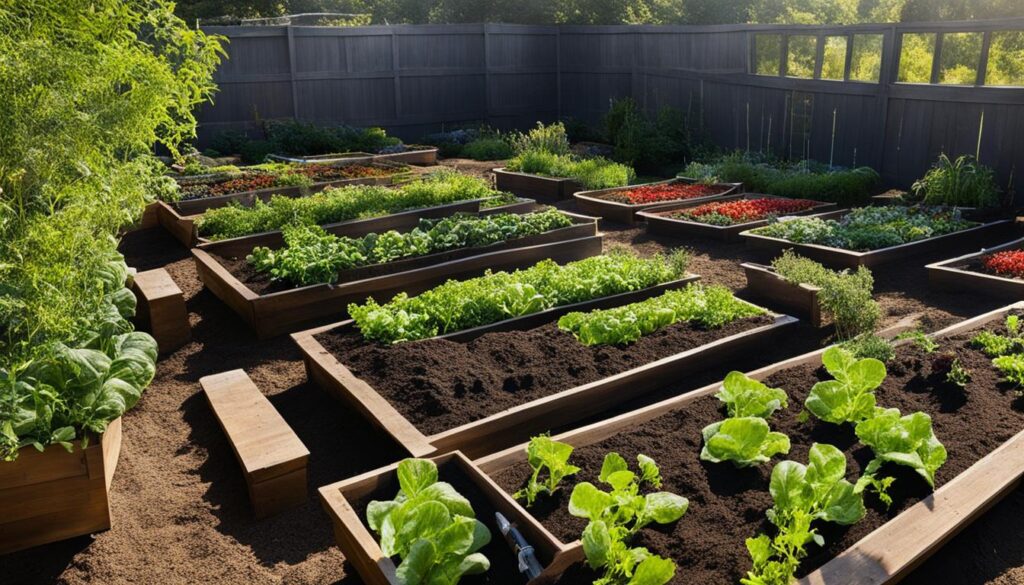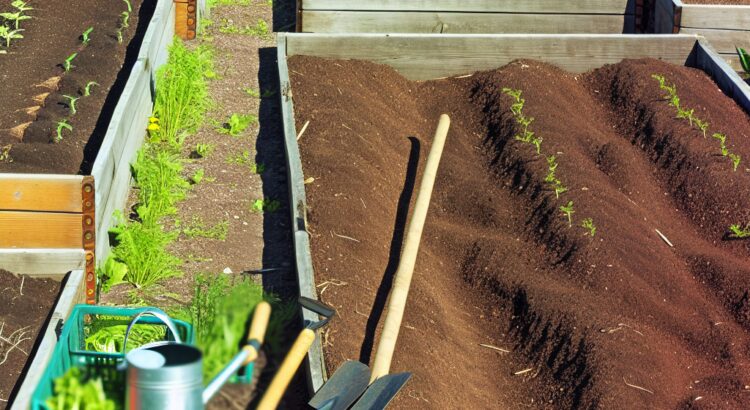Raised bed gardening is a popular method that offers numerous benefits for both beginners and seasoned gardeners. By properly preparing your raised bed garden, you can create an optimal growing environment for your plants to thrive. In this guide, we will provide you with essential tips for choosing the right raised bed, siting and filling it with quality soil, and tending to your garden throughout the season.
Key Takeaways:
- Choosing the right raised bed is crucial for the success of your garden. Consider factors such as material, size, and depth.
- Siting your raised bed in a location with ample sunlight and good drainage is essential.
- Fill your raised bed with high-quality soil designed for raised bed gardens, incorporating organic matter for enhanced fertility.
- Select plants that thrive in your climate and follow best practices for seeding, transplanting, and caring for your garden.
- Enjoy the benefits of raised bed gardening, including a longer growing season, better soil quality, and bigger harvests.
Choosing the Perfect Raised Bed for Your Garden
When it comes to choosing a raised bed for your garden, there are several factors to consider that will ensure the best results for your plants. The material, size, and depth of the raised bed all play a crucial role in creating an ideal growing environment.
Firstly, it’s important to select a material that is durable, weather-resistant, and non-toxic. Gardener’s Supply offers a wide range of raised beds made from materials such as durable cedar, composite, and metal. Each material has its own advantages, so choose one that suits your preference and budget.
The size and depth of the raised bed are also crucial considerations. The size should be determined by the available space in your garden and your gardening goals. Consider how many beds you will need to accommodate your desired plants and the layout you have in mind. Additionally, the depth of the bed will determine the amount of soil available for plant roots to grow. Remember to use the Soil Calculator to determine how much soil you’ll need for each bed.
Table: Comparison of Raised Bed Materials
| Material | Advantages | Disadvantages |
|---|---|---|
| Cedar | Durable, naturally resistant to rot and pests, visually appealing | Higher cost, requires occasional maintenance |
| Composite | Durable, low maintenance, eco-friendly | Higher initial cost |
| Metal | Durable, long-lasting, modern aesthetic | May heat up more quickly in direct sunlight |
Choosing the perfect raised bed for your garden is an essential step in creating a successful gardening experience. Consider the material, size, and depth of the bed to ensure optimal conditions for your plants to thrive. Gardener’s Supply offers a wide selection of raised beds to suit various needs and preferences, making it easy to find the perfect fit for your gardening goals.
Siting and Filling Your Raised Bed Garden
Choosing the right location for your raised bed garden is crucial for its success. Look for an area that receives at least 8 hours of sunlight per day, as most vegetables and herbs thrive in full sun. Good drainage is also important to prevent waterlogged soil, which can lead to root rot and other issues. Avoid low-lying areas that tend to collect water or stay wet after rainfall.
Additionally, consider the proximity of your water source when siting your raised bed garden. It’s essential to have easy access to water for regular irrigation. If your water source is far away, consider using drip irrigation systems or installing a rainwater collection system.
When it comes to filling your raised bed, the quality of the soil is key. Use high-quality, nutrient-rich soil that is specifically designed for raised beds. This type of soil is typically lighter and more well-draining than regular garden soil, allowing for better root development and healthier plants. The amount of soil you’ll need depends on the size and depth of your raised bed. You can use the Soil Calculator to determine the exact amount required.
Table: Comparison of Different Types of Soil for Raised Beds
| Soil Type | Advantages | Disadvantages |
|---|---|---|
| Organic Soil | – Rich in nutrients – Promotes healthy plant growth – Improves soil structure |
– More expensive than other options – Requires additional amendments for specific plant needs |
| Potting Mix | – Lightweight and well-draining – Sterile and free from weeds and pests – Ideal for container gardening |
– Can be cost-prohibitive for large raised beds – Requires regular fertilization |
| Topsoil | – Affordable option – Contains natural nutrients – Easily accessible |
– May contain weed seeds and pathogens – Heavy and prone to compaction – Requires supplemental amendments |
Incorporating organic matter into your raised bed soil can further enhance its fertility. Compost is an excellent choice, as it adds nutrients, improves soil structure, and retains moisture. Aim to mix in compost at a ratio of about 1 part compost to 3 parts soil. This will provide a balanced growing medium for your plants.
Planting and Tending Your Raised Bed Garden
Once you have prepared and filled your raised bed garden, it’s time to start planting and tending to your plants. Choosing the right vegetables and herbs that are suitable for your climate and personal preferences is key to a successful raised bed garden. Consider factors such as sunlight requirements, growing season, and space availability when selecting your crops.
When planting in raised beds, it’s important to follow best practices for seeding and transplanting. Proper spacing between plants helps prevent overcrowding and allows each plant to receive adequate nutrients and sunlight. Additionally, be mindful of the recommended soil temperature for each crop to ensure optimal growth.
Implementing trellises and stakes can provide support for tall crops like tomatoes and peas, allowing them to grow vertically and utilize the space more efficiently. This not only helps conserve space in your raised bed garden but also facilitates easier maintenance and harvesting.
Essential Tips for Tending Your Raised Bed Garden
- Regularly monitor and water your raised bed garden to maintain adequate moisture levels. The intensive planting method in raised beds helps retain moisture, but it’s important to avoid overwatering, as it can lead to root rot.
- Remove weeds regularly to prevent them from competing with your plants for nutrients and space. Mulching around your plants can help suppress weed growth.
- Protect your plants from pests by implementing organic pest control methods such as companion planting, handpicking, or using natural insect repellents.
- Monitor weather conditions and provide necessary protection, such as using row covers or shade cloth, to shield your plants from extreme heat or cold.
By following these planting and tending tips, you can ensure the success of your raised bed garden and enjoy a bountiful harvest of fresh, homegrown produce.

Conclusion
Raised bed gardening is a fantastic option for beginners and experienced gardeners alike. By following these guidelines, you can create an optimal growing environment and enjoy the numerous benefits that raised bed gardening offers.
One of the key advantages of raised bed gardening is the longer growing season it provides. With the elevated soil temperature and improved drainage, you can start planting earlier in the spring and continue harvesting well into the fall.
Another significant benefit is the enhanced soil quality in raised beds. By filling your beds with nutrient-rich soil and incorporating organic matter like compost, you create a fertile and well-balanced environment for your plants to thrive. This results in healthier plants, bigger harvests, and tastier produce.
Additionally, raised beds offer easier access and maintenance. Their elevated height reduces the strain on your back and knees, making it more comfortable to tend to your garden. With fewer weeds to contend with, you can spend less time on maintenance and more time enjoying the fruits of your labor.
Get Started with Raised Bed Gardening Today!
Whether you have a small space or a large backyard, raised bed gardening is a fantastic way to grow your own food. With the proper preparation, choosing the right materials, and providing the ideal growing conditions, you can reap the rewards of a bountiful harvest.
So, why wait? Start your raised bed garden today and experience the joys of gardening in a convenient and productive way. Whether you’re a beginner or a seasoned gardener, you’ll love the simplicity, versatility, and numerous benefits that raised bed gardening has to offer.
FAQ
What are the benefits of raised bed gardens?
Raised bed gardens offer numerous benefits, including a longer growing season, better soil quality, bigger harvests, and easier access.
How do I choose the right raised bed for my garden?
When selecting a raised bed, consider factors such as the material, size, and depth. Gardener’s Supply offers a wide range of raised beds to suit different needs and preferences.
How deep should my raised bed be?
The depth of the bed is important, as it determines the amount of soil available for plant roots to grow. Use the Soil Calculator to determine how much soil you’ll need for each bed.
How many raised beds should I have?
The number of raised beds you should have depends on the space and your gardening goals. Use the Kitchen Garden Planner to plan the layout of your raised bed garden.
Where should I locate my raised bed garden?
Choose a location that receives at least 8 hours of sunlight per day and has good drainage. Avoid wet areas to prevent constant saturation of the soil. Consider the proximity of your water source for easy access.
What kind of soil should I use for my raised bed garden?
When filling the raised bed, use high-quality, nutrient-rich soil that is specifically designed for raised beds. The Soil Calculator can help you determine how much soil you’ll need. Incorporate organic matter such as compost to enhance soil fertility.
What should I plant in raised beds?
Choose vegetables and herbs that you enjoy eating and that will thrive in your climate. Follow best practices for seeding and transplanting, ensuring proper spacing and soil temperature. Implement trellises and stakes for supporting tall crops like tomatoes and peas.
How do I maintain my raised bed garden?
Regularly monitor and tend to your raised bed garden by watering, weeding, and protecting plants from pests and weather conditions.
Are raised bed gardens suitable for beginners?
Yes, preparing raised bed gardens can be a rewarding experience for beginners and seasoned gardeners alike. By following these guidelines, you can create an optimal growing environment and enjoy the many benefits that raised bed gardening offers.
